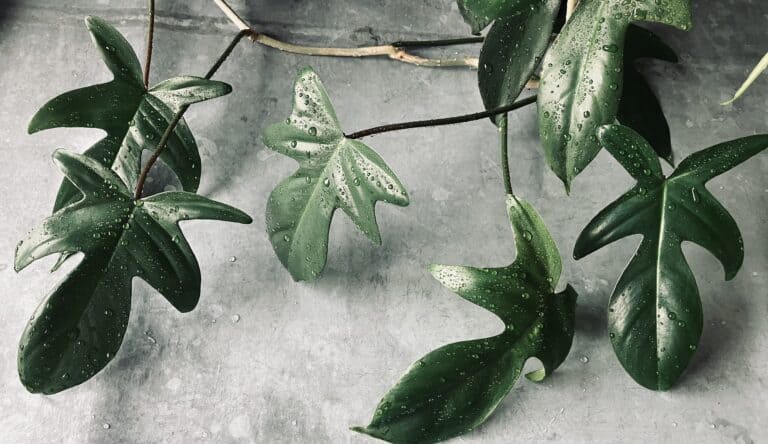Which Philodendrons Do Not Climb?
If you are asking that question, you are aware of the fact that not all Philodendron varieties are made alike. But what are those non-climbing varieties? Are they common? And do they require any extra care and maintenance to keep bringing joy to your home?
There are two types of nonclimbing, philodendron: there are three like varieties, like philodendron bipinnatifidum (also known as P. Selloum), that have a real tree-like trunk, and then there are self heading philodendron varieties that have a normal-looking grass-like stem, but don’t do not require support for keeping upright. Usually this second group has leaves growing closer to one another then the “traditional” vining varieties. In this article we dig into both of these groups and touch on some of the most popular representatives of them.
It’s true that most of the time, when we hear the word ‘Philodendron’ most of us imagine a long vine with lush green and likely heart-shaped leaves. When my mother-in-law says “I don’t like Philodendrons” (unthinkable, I know), she pictures exactly those vining varieties. However, these beloved houseplants are incredibly diverse, with variations in size, shape, and color beyond imagination of even the most picky of plant lovers.
A plant nerdy fact: Recent genetic research revealed distinct groups of Philodendrons, including arborescent and self-heading varieties, which do not necessarily wish to climb.
So, let’s focus on these two groups.
Tree Philodendrons
Let’s start with the least climbing category – the arborescent philodendrons. A perfect representative of this group is Philodendron Bipinnatifidum (also known as Philodendron Selloum) and its numerous descendants, many of which were cultivated in various nurseries throughout the world.
In tropical and subtropical countries these plants are often grown outdoors. And those of us who live in colder climates enjoy using them in indoor landscaping to create out own piece of jungle at home.

What do arborescent Philodendrons look like?
When they are young, those plants resemble their self-heading cousins that we’ll dig into later on, but as they mature they take on more woody and treelike shapes. The leaves of these plants form a fancy foliage crown at the top of the trunk and as the older leaves die out, they leave those twisty marks along the stem, so that you can actually see where the leaves used to be.
Even though these plants have thick woody stems, it’s not uncommon to spot roots growing all along the stem. Just like in other aroids, these roots come in two flavors: anchor roots, which are usually smaller and help the plant cling to a nearby tree. They don’t need any support to grow upwards, but if there’s a tree nearby, they like to give it a friendly hug for extra stability. The second type of roots are feeder roots, which are thicker, and they act as the stem’s connection to the soil, helping the plant get the water and nutrients it needs.
It’s worth mentioning that these roots don’t always show up; they pop up based on what the plant needs. As these tree-like philodendrons can grow in soil, on rock or on trees (as hemi-epiphytes) and depending on how close they are to water and food on one hand, and how much stability the plant craves on the other, it decides which type of roots to sprout. When they’re growing in a pot, these plants can get a bit top-heavy and favor one side for growth. So, to stop them from tumbling over, you might need some kind of stick to keep them standing tall.
What do arborescent Philodendrons like?
Tree-like philodendrons prefer more open environments with higher light intensity as compared to their vining cousins. Where the forest is dense, these plants prefer hemi-epiphytic living, using bigger trees to get closer to the light and shooting long feeder roots down to the soil for water and nutrients. They grow like small trees on bigger trees.
When you spot these tree-like philodendrons growing in soil, they typically prefer medium to bright light, often hanging out on the edges of forests or in open spaces. These hardy plants can handle a bit of drought and can even tough it out in temperatures near freezing (32°F / 0°C).
What are the most popular tree-like Philodendrons?
Philodendron Bipinnatifidum has played a significant role in various breeding programs, and recent research shows that it’s closely related genetically to many popular hybrids and cultivars. Many of these still go by the name ‘Philodendron Selloum’.
One sought-after beauty in this family is Philodendron Xanadu, a smaller version of P. Bipinnatifidum. While the wild ancestor can sprawl out to 10 feet (3 meters) in diameter, the Xanadu hybrid has a more compact look, making it a great fit for interior decorating.

If you’re on the hunt for an even tinier tree-like Philodendron, consider P. Hope. It’s a dwarf version of P. Selloum, chosen for its toughness. When it’s planted outdoors, P. Hope sheds its leaves at 26.6°F (-3°C), but the stem can endure temperatures as low as 10.4°F (-12°C) and bounce back with fresh foliage in the next summer.
Self-Heading Philodendrons
Another non-climbing group of Philodendrons is very colorful. It’s there that we can find all the possible shades of yellow, orange, red and brown. Many of these are hybrids that do not exist in nature. And most of them are descendants of Robert McColley’s breeding program that brought many novelties in the market of foliage plants.
In the swinging 1960s, Robert McColley went all in, creating hundreds of Philodendron combos by mixing over 15 different species in every way imaginable. He ended up with millions of hybrid seedlings. Even though only a small part of his work got officially patented, he’s basically the proto-creator of nearly every hybrid Philodendron we have today.
What do self-heading philodendrons look like?
Leaves of self-heading Philodendrons form a more or less compact rosette, somewhat like lettuce, but with more tough, leathery leaves. They have a very short stout stem with very short internodes between the leaves, thus usually the question of support does not emerge with these plants.
McColley’s hybridization efforts had two objectives: on the one hand, he selected plants with the highest aesthetic value. That is why the best results are so colorful. On the other hand, the seedlings passed through severe changes in humidity, light and temperature to make sure that the breeding program ‘graduates’ can survive whatever comes their way, from long transportation to eventual mishaps of novice plant-parents.
What do self-heading philodendrons like?
One of the wild self-heading Philodendrons that played a big role in McColley’s experiments was Philodendron wendlandii. In its natural habitat, nestled high in the Central American rainforest canopy, it enjoys an epiphytic life, basking in the sunlight without the need to climb up for it. So, does this mean that self-heading Philodendrons generally crave more light compared to their climbing cousins?
In terms of genetics, yes, they do tend to prefer more light. However, as mentioned earlier, the hybrid varieties are usually hardier than their original counterparts and are bred to thrive in typical indoor conditions. This means they can flourish in a wide range of environments, although pushing them to extremes might result in them losing some of their vibrant charm.
…At very high temperatures the glossy-orange color may become a dull yellow bronze. This same color change may result from very high light intensities, and is opposed to the concept for which it was developed, which was for its intense bright-orange color that is much in demand by interior plantscapers.
US Plant Patent #6,797 – Philodendron plant named Prince of Orange
What are the most popular self-heading Philodendrons?
Self-heading Philodendron hybrids are a colorful crowd, with plant varieties for every taste. There are some very bright personalities among them.
‘Moonlight’ is a ray of sunshine with its bright, cheerful yellow-green oval leaves, sure to bring some radiance to any spot.
‘Autumn’ is a true chameleon, sporting coppery-orange new growth that matures into a deep, rich green. Its thick, leathery leaves make a bold and beautiful statement.
Now, let’s talk classics! ‘Imperial Green’ and ‘Imperial Red’, both patented hybrids from the 1980s, were plucked from McColley’s seedlings by Paul DeCoster in Mello, Belgium. ‘Imperial Green’ boasts large, glossy leaves that seem to shimmer in the light, while ‘Imperial Red’ wows with its dark red stems and the undersides of its leaves, giving it a striking appearance.
‘Prince of Orange’ steps into the limelight with its unique bright orange new growth, a stunning contrast to its dark green, mature leaves. It’s a standout addition to any collection.
For a touch of drama, feast your eyes on ‘Black Cardinal’ with its deep burgundy leaves. Placed in a sleek black ceramic pot, it brings a moody vibe to your living room.

These are just a few of the self-heading Philodendrons that can elevate your plant collection. Keep an eye out for these varieties—they’re compact, hardier than they seem, easy to care for, and adapt perfectly to our indoor conditions. A colorful, low-maintenance crew ready to spruce up your space!
Key Takeaways
In the wild, non-climbing Philodendron types don’t bother with climbing because they’ve figured out other ways to get their sunlight fix. Some chill up high as epiphytes in the canopy, while others hang out in soil or on rocks near the forest edges and clearings, where they soak up plenty of sunshine.
Now, the non-climbing hybrid varieties, specially bred to thrive indoors, are a breeze to take care of and come in all sorts of shapes and colors. They’re compact, skip the whole moss pole drama, and can add that extra touch of magic to any room.
Even though these plants are pretty tough, in some cases suboptimal conditions may impact the appearance of your plant, reducing its aesthetic appeal. Your plant might drop some leaves, get leggy or fade down its vibrant colors as a way of telling you it’s not too happy with the setup.
The main tips here are as follows:
- If your plant is getting leggy in some way, growing longer stems or petioles to get the leaves closer to the nearest window, then it might lack light. So, before thinking about moss poles, trellis or other types of support, consider giving it the light conditions that it craves.
- If your plant is getting paler, think about various aspects of care, check for extremes: are the temperatures too high lately? Is your plant too close to the window ? When was the last time you fertilized it? Try to make some small changes.
The good news is these plants are very forgiving and will get back to normal as soon as the hard patch is passed.
Happy landscaping!
Sources:
- Mayo, Simon. (1991). A Revision of Philodendron Subgenus Meconostigma (Araceae). Kew Bulletin. 46. 601.
- Devanand, & Chen, Jianjun & Chao, Chih-Cheng & Henny, Richard. (2004). Assessment of Genetic Relationships among Philodendron Cultivars Using AFLP Markers. Journal of the American Society for Horticultural Science. American Society for Horticultural Science. 129. 690-697.
- McConnell, Dennis & Chen, Jianjun & Henny, Richard & Everitt, Kelly. (1969). Cultural Guidelines for Commercial Production of Interiorscape Philodendron. EDIS. 2003.



